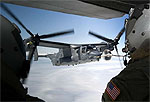Ospreys head to Mildenhall; lawmakers try to block funding
 The first CV-22 Ospreys have touched down at RAF Mildenhall, England, beginning a new phase for Air Force special operators in Europe.
The first CV-22 Ospreys have touched down at RAF Mildenhall, England, beginning a new phase for Air Force special operators in Europe.
But the fleet might face an uncertain budget future.
The first of the 10 tilt-rotor aircraft made the flight across the ocean and touched down at RAF Mildenhall, England, earlier this summer, with the rest expected to arrive through the end of 2014.
But the stay might not be long if some on Capitol Hill get their way. The Senate Appropriations committee, in its report on the fiscal 2014 military construction funding bill, is looking to block funding for the Ospreys, citing the distance from England to Africa and the placement of Marine MV-22s at Moron Air Base, Spain.
The Air Force, in its fiscal 2014 budget proposal, asked for $66 million in military construction for Mildenhall, which would be used for airfield pavement, a hangar, parts storage and an operations facility. The base has already received funding for the move, including about $6.5 million for a training simulator.
The Senate Appropriations report also cites the importance of Naval Air Station Sigonella, Italy, for counterterrorism activity in questioning the decision. “Sigonella has become a key launch pad for missions related to Libya, and given the ongoing turmoil in that nation as well as the emergency of terrorist training activities in northern Africa, the committee believes that the Special Operations Command should re-evaluate the decision to beddown the [special operations] CV-22 mission at Mildenhall,” the report states.
The committee also fenced funding for the remaining construction projects in both the United Kingdom and Germany until the Defense Department finishes a study on consolidating U.S. forces in Europe. In addition to the Ospreys, 12 MC-130J Commando IIs will move to Mildenhall over the next five years.
The CV-22s sent to Mildenhall will be assigned to the 352nd Special Operations Group, which will increase the base population by about 900 people, including families. The Ospreys are filling a hole left by the retirement of MH-53 Pave Lows in 2007.
“It brings a new capability to the [European Command] theater that hasn’t really been here for a while and I think that was when the MH-53 departed, the vertical lift piece of this departed with it,” said Lt. Col. Chris Goodyear, director of operations with the 7th Special Operations Squadron, when the first Osprey landed.
The 7th Operations Squadron is tasked with night, adverse-weather, long-range insertion, extraction, and resupply operations.
“[The CV-22] brings that vertical lift capability where you can land in austere locations that don’t necessarily require a runway,” Goodyear said in a release. “So it gives you access to places that you normally wouldn’t have with a fixed-wing aircraft.”
This movement marks the first overseas CV-22 squadron. Gen. Herbert “Hawk” Carlisle, commander of Pacific Air Forces, said earlier this month that PACAF is finalizing its plan to base Ospreys in Japan.
The service plans to field 49 operational CV-22s assigned to AFSOC, with the aircraft also based at Hurlburt Field, Fla., and Cannon Air Force Base, N.M.
The aircraft has been deployed and seen extensive use in Afghanistan. In 2012, CV-22s completed 1,022 sorties, hauling more than 135,000 pounds of cargo and extracting 299 detainees, Lt. Gen. Burton Field, the deputy chief of staff for operations, and Lt. Gen. Charles Davis, the military deputy in the office of the secretary of the Air Force for acquisition, told lawmakers earlier this year.